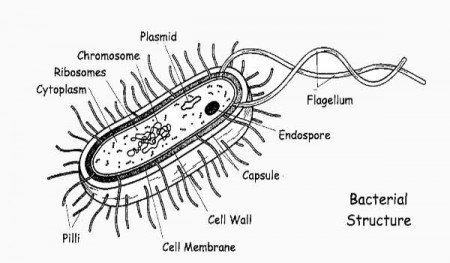The simplest microscopic one-celled chlorophyllous organism which has the underdeveloped nucleus and lacking nucleolus and nuclear membrane is called Bacteria. They are the prokaryotic type of cell. They can synthesize other organic substances by proucing ATP.
Discovery: In 1675, Anthony Von Lewen Hook discovered bacteria.

Characteristics
1) They are microscopic organisms.
2) They are unicellular, but many cells can live together in a colony.
3) They are prokaryotic, therefore nuclear membrane is absent.
4) They may be saprophytic or autotrophic in nature.
5) They reproduce by amitosis following binary fission.
Habitat
1) The presence of bacteria is everywhere in the world. It exists everywhere, in soil, water or air, even in dead bodies and organic substances.
2) They are found to live in the intestines of different animals including humans.
3) Plenty of bacteria exist in soil, enriched with organic substances.
4) A great deal of bacteria are found in faecal matters of some animals including humans.
5) They exist in water, enriched with organic substances.
6) The lower part of the atmosphere contains a lot of bacteria.
Economic Importance of Bacteria:
Harmfulness:
Human diseases: It’s cause a number of diseases to humans, such as- Typhoid, Pneumonia etc.
Animal diseases: Animals suffer from diseases, such as- Anthrax, Chicken-cholera etc.
Plant diseases: There are several bacterial diseases of plants e.g. Ring spot of Tobacco, Bacterial wilting of Tobacco, Cotton root rot etc.
Spoilage of food: Spoilage of fruits, butter, milk etc, may be caused by bacteria.
Loss of soil fertility: Some bacteria, convert nitrite and nitrate into nitrogen which later escape in air causing a loss of soil fertility.
Usefulness:
Medicine: Extracts from bacteria are used to prepare antibiotics Such as- Polymixin, Tyrothricin etc.
Food Industry: A good number of food products are manufactured due to bacterial activities e.g. Butter, Cheese etc.
Industry and Agriculture: Some are used in industries and also in Agriculture.
- The tanning of leather.
- Extraction of fibres from jute and hemp.
- Prouction of vinegar, acetone, lactic acid, citric acid, vitamins etc.
- Some bacteria called nitrogen fixing bacteria fix nitrogen in soil and thus increase soil fertility.













